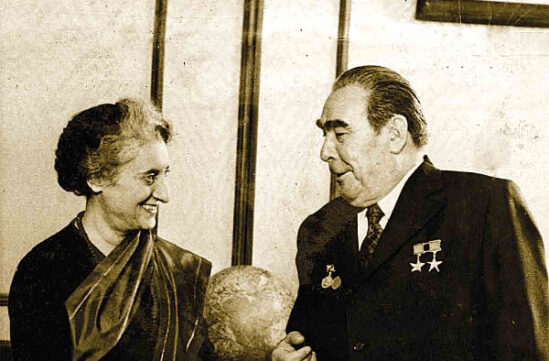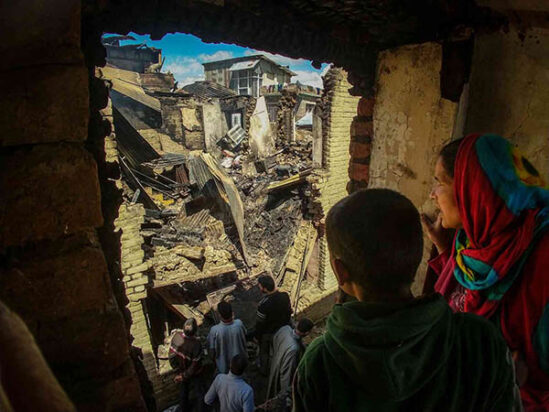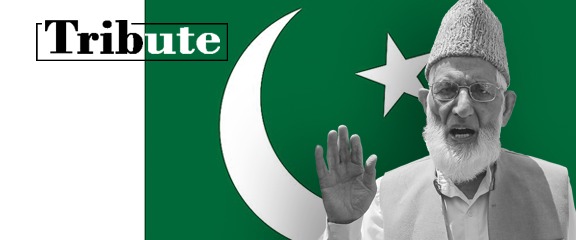“We cannot cut off our lines of communication with the countries or forces that do not see eye-to-eye with us on Kashmir. Engagement with them is imperative. But, at the same time, we need to make new allies and remain in the international realm to build pressure to pave the way for multilateral diplomacy to resolve the Kashmir dispute.”
Sardar Masood Khan,
President, Azad Kashmir.
The Kashmir issue is simply this: the people of a vast territory, which is not part of any existing sovereign state, were assured by the entire international community, represented by the United Nations, that they would be enabled to decide their future through a free vote. Until now, this pledge has not been honoured. Instead, under military occupation by India, a barbarous rule has been foisted on them. Their current uprising is the culmination of a non-violent resistance movement sustained over seven decades, in the face of endless persecution. It suits the guilty party, India, to quibble over the issue and make it look abstruse and forbiddingly intricate. The false intricacy, in turn, provides an alibi to others to temporise and postpone a just and fair settlement of the dispute. Meanwhile, the people of Jammu & Kashmir have to bear the painful cost of this in the form of countless inquires, death, destruction and intense suffering.
The ceasefire line between the forces of India and Pakistan has currently divided Kashmir into two parts. One part is under Indian occupation: this comprises 63 percent of the whole territory and includes the Valley; it has a population of around 12.8 million. The other, with around 4.3 million people, includes Azad (free) Kashmir, which is under indirect Pakistani control, and 1.3 million people in the northern region of Gilgit and Baltistan, which is directly administered by Pakistan. About 2 million Kashmiris are refugees in Pakistan: some 800,000 live in Britain and about 1 million are scattered around the world.
A society with a settled historical continuity of its own, Kashmir has been independent over long periods of time spanning centuries. During the colonial era, however, it was one of the principalities called States, which were ruled by hereditary feudal chiefs (Maharajahs or Nabobs) and granted internal autonomy by Britain as the paramount power. The Maharajah of Jammu and Kashmir was the descendant of a freebooter, who obtained the territory from the British East India Company in return for the payment of a sum of money in 1846. The resentment of the people of Kashmir at having been treated as chattel in this sale deed remained inarticulate during the early colonial period but exploded in a freedom movement in 1931. It led to the ‘Quit Kashmir’ campaign against the Maharajah in 1946, and to the Azad Kashmir movement which gained momentum a year later. The first armed encounter between the Maharajah’s troops and insurgent forces occurred in August 1947.
At that time, Britain was liquidating its empire in the subcontinent. The tripartite agreement of Britain, the National Congress (representing Hindus) and the Muslim League (representing Muslims) partitioned British India into two independent countries: one comprising Hindu majority areas which retained the name ‘India’ and the other including Muslim majority areas which named itself Pakistan. As this settlement also meant the end of British paramountcy over the autonomous principalities called States, these were supposed to merge with either one of the two countries in accordance with the wishes of the people and the principle of Partition (Hindu majority States with India and Muslim majority States with Pakistan). Kashmir was a predominantly Muslim majority State; besides, it was far more contiguous with Pakistan than with India. It was, therefore, expected to accede to Pakistan. But the Hindu Maharajah rejected the first option and could not manage the second.
Faced with the insurgency of his own people, who were joined by a few hundred civilian volunteers from Pakistan, the Maharajah fled the capital Srinagar, on October 25, 1947, and arranged for India to send its army to help him crush the rebellion. India, coveting the territory, agreed to the armed intervention on the condition that the Maharajah sign an Instrument of Accession to India. He agreed, but India did not even wait for his signature to fly its troops into the State.
A warlord had acquired Kashmir and his fief in 1846 through a sale deed, and in 1947 his descendant transferred Kashmir as a piece of property to India. Though 101 years apart, the two acts were identically colonialist in nature, provoking the same popular outrage. One difference, however, was that the first took place in the colonial era and required no legitimacy; the second occurred in the post-colonial age, after the coming into force of the United Nations Charter.
Though long-planned and swiftly executed, the annexation of Kashmir could not have been a simple affair for India. First, there was the incongruity of the act, which clearly violated the principle of Partition. Secondly, while accepting the Instrument of Accession from the Maharajah, India did not wish to jeopardise its chances of annexing two other principalities or States (Hyderabad and Junagadh) which, in contrast with Kashmir, had Hindu majorities but Muslim rulers. It had a stake, therefore, in ostensibly preserving the principle that in case of a conflict between the ruler’s and the people’s wishes, the latter must prevail. Under these compulsions, India had to attach a condition to the transaction with the Maharajah: the accession was made subject to a “reference to the people.”
Between October and December of 1947, the Azad Kashmir forces successfully resisted India’s armed intervention and liberated one-third of the State. Realising that it could not quell the resistance, India took the issue to the United Nations in January 1948 for a settlement of the dispute. The Security Council discussed the question exhaustively from January to April 1948. Since both parties to the dispute desired that the question of accession should be decided through an impartial plebiscite, the Council developed proposals based on the common ground between them. These were embodied in the Security Council Resolution 47, of April 21, 1948, that envisaged a ceasefire, the withdrawal of all outside forces from the State and a plebiscite to be held under the control of an administrator, who would be nominated by the Secretary General.
A development that hardened India’s stance was Pakistan’s joining military pacts sponsored by the United States. From 1955 onwards, India took the position that, in view of this alliance between the two, it could no longer countenance the withdrawal of its forces from Kashmir. Despite repeated pleas that the withdrawal was not meant to be unilateral in any case and that Pakistan would do the same in coordination, India refused to budge from its position. And it found a ready supporter in the Soviet Union which, after 1958, blocked every attempt by the Security Council to defreeze the situation and implement the peace plan originally accepted by both parties. This situation has persisted from 1958 to the present day. Not even two full-scale wars between India and Pakistan in 1965 and 1971 have helped break this deadlock.

Kashmir could not remain untouched by the tide of freedom which rolled across the world in the late 1980s, sweeping away the Soviet military invasion of Afghanistan and the Iraqi occupation of Kuwait, South Africa’s 70-year-old rule over Namibia and the unpopular establishments in Eastern Europe. Inspired by it, the people of Kashmir intensified their struggle against the unwanted, tyrannical Indian occupation. Their uprising entered its current phase in July 1988. The scale of popular backing for it can be judged from the fact that, on many occasions since 1990, virtually the entire population of Srinagar came out on the streets in an unparalleled demonstration of protest against the oppressive status quo, marched to the offices of the United Nations Military Observers Group for India and Pakistan (UNMOGIP) and submitted memorandums to the Secretary-General of the United Nations. The fact that they presented petitions at the office of the UNMOGIP shows the essentially peaceful nature of the uprising and its trust in securing justice under international law. India has tried to portray the uprising as the work of terrorists or fanatics. Terrorists do not comprise an entire population, including women and children; fanatics do not look to the United Nations to achieve a pacific, rational settlement.
The indiscriminate killing of unarmed civilians and assaults on innocent women and children by Indian occupation forces have not been fully reported because India has banned the entry of the world media into the occupied territory.
What’s more, even the local media is not allowed to report any incident that takes place in the Kashmir Valley. However, despite these restrictions, the occasional reports that do leak out offer a glimpse into the reign of terror unleashed by India inside the occupied territory.
In the August 15, 2019 edition of The New York Times, Booker Prize winner Arundhati Roy wrote: “Today Kashmir is one of the most or perhaps the most densely militarised zones in the world. More than a half-million soldiers have been deployed to counter what the army itself admits is now just a handful of “terrorists.” If there were any doubts earlier, it should be abundantly clear by now that their real enemy is the Kashmiri people. What India has done in Kashmir over the last 30 years is unforgivable.”

The United Nations High Commissioner on Human Rights has issued a ‘Report on Kashmir’ which contains graphic documentation of human rights violations being committed by the Indian military and paramilitary forces in Indian-Occupied Kashmir. This constitutes a significant step towards greater international recognition of the serious abuses committed against Kashmiris by the Indian army. This report takes off the veil of secrecy shrouding India’s crimes against humanity.
The 49-page report cites specific instances where the Indian Government violated the basic principles of human decency and democratic freedom against Kashmiris. The report states that, “In responding to demonstrations that started in July 2016, Indian security forces used excessive force that led to unlawful killings and a very high number of injuries … One of the most dangerous weapons used against protesters during the unrest in 2016 was the pellet-firing shotgun.”
Furthermore, it states: “The government of India has passed legislation under the Jammu and Kashmir Disturbed Areas Act of 1990 which gives extraordinary power to all ranks of the Indian military and paramilitary forces.” These laws, the report emphasises, “have created structures that obstruct the normal course of law, impede accountability and jeopardise the right to remedy for victims of human rights violations.”
The report underscores that “Impunity for enforced or involuntary disappearances in Kashmir continues as there has been little movement towards credibly investigating complaints, including into alleged sites of mass graves in the Kashmir Valley and Jammu region.”
It is well-documented that the bloody occupation has resulted in massive human rights violations, particularly of women and children. The sanctity of women has been violated, in a gruesome and unforgiving fashion. The UN report upholds that in the 2013 report on her mission to India, the Special Rapporteur on violence against women, its causes and consequences, said, “Women living in militarised regions, such as Jammu and Kashmir and the north-eastern states, live in a constant state of siege and surveillance, whether in their homes or in public. Information received through both written and oral testimonies highlighted the use of mass rape, allegedly by members of the State security forces, as well as acts of enforced disappearance, killings and acts of torture and ill-treatment, which were used to intimidate and to counteract political opposition and insurgency.”
The established procedures of the United Nations will not facilitate the speedy intervention that both the humanitarian and the political aspects of the situation in Kashmir call for urgently. However, what the UN can do to bring relief to the people of Kashmir is, dispatch a fact-finding mission headed by a statesman or a high-ranking diplomat, to report expeditiously on the situation in Kashmir. The matter is much too urgent to be relegated to the routine mechanism of the Human Rights Council and the various bodies established to monitor assorted conventions. We trust that the United Nations Secretary General will bring its influence to bear on both India and Pakistan to initiate a peace process with which the UN as well as the leadership of the people of Jammu & Kashmir will be associated, so as to ensure that the settlement arrived at will be based on the principles of justice. It is up to us to make peace the destiny of Kashmir through all of our energies, goodwill, wisdom, and compassion for this once glorious land — a paradise on earth — that has been turned into a veritable hell through the machinations of successive Indian governments, most of all the present Modi government.



